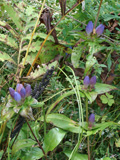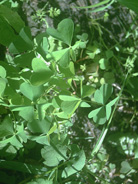 |

 |
Wild Edibles
Make sure to use a plant field guide to properly identify all plants before eating. This is a reference for cooking suggestions of common edible plants in the Northeastern part of the U.S.
AMARANTH - Amaranthus spp., aerial parts – The tender leaves can be boiled for 10-15 minutes as a sauté, used in salads and soups. The tiny black seeds are dried and harvested for a nutritious flour.
BURDOCK - Artica lappa, young leaves and roots – First year roots are harvested in the early spring or fall for stir-fry or soups. The tender young leaves can be added to salads or boiled in several changes of water and served as a green. Stems can be peeled to reveal a tender green to be eaten raw or cooked.
CATTAIL- Typha latifolia, young shoots and stalks, immature flower spikes, pollen, sprouts and rootstalks – Most versatile of our native edible plants. Young shoots can be eaten raw or baked or boiled, or cooked like asparagus after being peeled. The immature flower spikes can be boiled for a few minutes, served with butter and eaten like corn on the cob. Flower pollen (fluff) can be gathered, sifted through a strainer, ground finely and made into a protein rich flour when mixed half and half with wheat flour. In late summer, the small horn shaped sprouts can be added to salads, or boiled and served with butter. In late fall, the rootstalk can be made into white flour.
CHICKWEED – Stellaria media, aerial parts – The tender leaves and stems can be added to salads and served as greens. Can also be added to soups.
CHICKORY – Cichorium intybus, young leaves, roots – The young leaves are can be added to salads and served as steamed greens. The roots make an excellent coffee-like beverage when roasted in an oven until dark brown and brittle. Grind and prepare like coffee, using 1 1/2 tsp per cup of water.
CLOVER – Trifolium pretense, young leaves, flowerheads, seeds – Both red and white clover flower heads are eaten raw or in soups and stews, but the flowers and leaves can be difficult to digest raw. Soaking, steaming and boiling the flowerheads and young leaves, may increase digestibility. Clovers are both abundant and rich in protein. The dried flowerheads and seeds can be ground into a nutritious flour.
COMFREY – Symphytum officinale, young leaves – Chopped young leaves can be added to salads. The newly emerging leaves are excellent prepared like spinach. Older leaves are bitter, but if boiled in several changes of water are very edible.
DANDELION – Taraxacum officinale, young leaves, buds, root and flowers – Young leaves and flower petals can be added to salads, and sautéed with olive oil, garlic and lemon or balsamic vinegar. The young flowerbuds can be boiled for several minutes and served with butter and also pickled. The flowers can be made into wine, jellies, and dipped in batter and fried as fritters. The root makes a delicious coffee–like beverage when slowly browned in the oven until brittle. It can then be ground and perked like commercial coffee.
DAYLILLY- Hemerocallis fulva, young shoots, flowerbuds, flowers, tubers – Add the early shoots to salads or prepare like asparagus. Young flowerbuds can be prepared like green beans or when older like fritters. Use fresh flowers to make fritters or dried flowers to season stews.
FIDDLEHEADS – Matteuccoa struthiopteris (ostrich fern), small fern rolls - Harvest the tender little rolls of ferns almost as soon as they appear within an inch or two of the ground. Carefully brush out & remove the brown scales. Wash & cook the “heads” in a small amount of lightly salted boiling water for 20 minutes or steam for 20 minutes. Serve at once with melted butter. The sooner they are eaten, the more delicate their flavor.
GROUND IVY (GILL-OVER-THE-GROUND) – Glechoma hederacea, leaves – Excellent salad green all summer long. The tiny purple flowers add color to salads. It preceded hops as the main beer-brewing herb of the 16th century.
LAMB’S QUARTERS (PIGWEED) – Chenopodium album, tender leaves and tips, seeds – The leaves and tips are excellent in salads, steamed as greens, and added to soups. Considered nature’s spinach. The highly nutritious seeds can be boiled to make a breakfast gruel, or ground into flour.
MILKWEED – Asclepias syriaca, young shoots, leaves, unopened flowerbuds, flowers, young pods – Young shoots up to six inches are eaten like asparagus, raw or cooked. Tender young top leaves, flowerbuds, and small, young, hard pods must be boiled two to three times. The flowers can be dipped in batter, fried and made into fritters.
MALLOW - Malva spp., young leaves, flowers – The young leaves can be used in salads and used to thicken soups and stews. They can be boiled or steamed and served with butter. The flowerbuds can be pickled.
MUSTARD – Brassica spp., young leaves, flowerbuds, young seedpods, and seeds – The entire plant is rich in vitamins A, B1, B2, C and protein. Tender young leaves and flower heads are good steamed as greens and are good in salads. Unopened flowerbuds are a delicious substitute for broccoli. The green seedpods, collected while the flowers are still in bloom, and be pickled or added to fresh salads. The ripe seeds are used as seasoning in pickling recipes and make a spicy hot yellow mustard when finely ground.
NETTLES – Urtica dioica, young shoots and leaves – The young shoots and leaves can need to be steamed of boiled for ten to fifteen minutes and can be served with butter and lemon. Excellent added to soups and stews. Used very much like spinach or kale. Leaves contain vitamins A, C, iron and protein. Use gloves to harvest due to formic acid on the plant. This acid is deactivated when steamed or boiled.
PLANTAIN – Plantago major, young leaves – The young leaves can be chopped and added to salads, or boiled and served with butter. Older leaves that are not too tough can be added to soups or blended into pesto.
PURSLANE – Portulaca oleracea, leaves, stems, and seeds – The stems and leaves are excellent added to fresh salads, soups, sautes and stews. They can be boiled and eaten as greens. The stems can be pickled, and the tiny seeds can be made into a nutritious flour. The leaves and stem are rich in iron, vitamin A, C, calcium and phosphorus.
VIOLET – Viola papilionacea, young leaves and flowers – young leaves can be added to salads and steamed or boiled for cooked greens. They can be added to soups and stews as a thickener. Flowers can be made into jellies and cordials or candied to decorate desserts. Leaves are rich in vitamins A and C.
SHEEP SORREL (SOURGRASS) – Rumex acetosella, leaves and stems – Use raw in salads, steam and serve with butter. Great as a tea-chilled and sweetened as lemonade. Rich source of vitamin C.
SHEPARD’S PURSE – Capsella bursa-pastoris, young leaves and seedpods – Add young leaves to salads, or prepare like spinach. Gather before flowers appear. Dried seedpods can be used as a pepper-like seasoning.
THISTLES – Cirsium spp., young leaves, stems and roots - Remove spines. Young leaves can be added to salads or cooked as greens. Young stems are excellent peeled and eaten raw or cooked. First year roots are a survival food.
WILD CARROT (QUEEN ANN’S LACE) – Daucus carota, roots – DO NOT CONFUSE WITH POISON HEMLOCK! – Prepare the first year roots like garden carrots.
WILD LEEK (RAMP) – Allium tricoccum, leaves, bulbs – Our best wild onion. Both leaves and bulb can be used in salads, stews, soups, sautéed, pickled, and as seasoning.
WILD LETTUCE – Lactuca Canadensis, young leaves and developing flowerheads – the young leaves can be added to salads and make a great soup additive. The developing flowerheads impart a unique flavor when added to casseroles.
Kelley teaches plant ID and wild food cooking in her Honoring Herbal Traditions Herbal Apprenticeship.




